
Centaurea is a genus of over 700 species of herbaceous thistle-like flowering plants in the family Asteraceae. Members of the genus are found only north of the equator, mostly in the Eastern Hemisphere; the Middle East and surrounding regions are particularly species-rich.
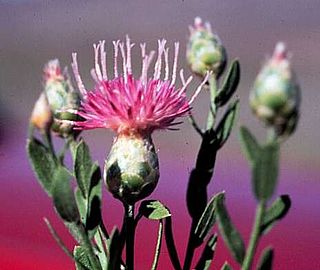
Rhaponticum repens, synonyms including Acroptilon repens and Leuzea repens, with the common name Russian knapweed, is a species of bushy rhizomatous perennial, up to 80 cm tall. Stems and leaves are finely arachnoid-tomentose becoming glabrous and green with age. The rosette leaves are oblanceolate, pinnately lobed to entire, 2–3 cm wide by 3–8 cm long. The lower cauline leaves are smaller, pinnately lobed; the upper leaves become much reduced, sessile, serrate to entire. The heads are numerous terminating the branches. Flowers are pink to purplish, the marginal ones not enlarged. The outer and middle involucral bracts are broad, striate, smooth with broadly rounded tips; the inner bracts are narrower with hairy tips. Pappus present with bristles 6–11 mm long. Fruit is a whitish, slightly ridged achene.
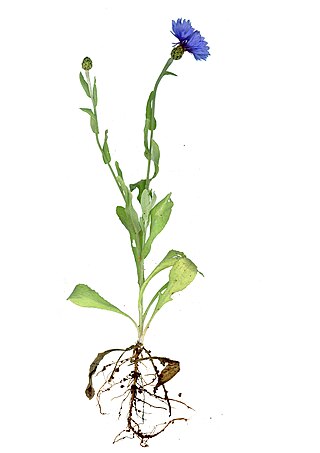
Centaurea cyanus, commonly known as cornflower or bachelor's button, is an annual flowering plant in the family Asteraceae native to Europe. In the past, it often grew as a weed in cornfields, hence its name. It is now endangered in its native habitat by agricultural intensification, particularly by over-use of herbicides. However, Centaurea cyanus is now also naturalised in many other parts of the world, including North America and parts of Australia through introduction as an ornamental plant in gardens and as a seed contaminant in crop seeds.

Centaurea scabiosa, or greater knapweed, is a perennial plant of the genus Centaurea. It is native to Europe and bears purple flower heads.

Centaurea diffusa, also known as diffuse knapweed, white knapweed or tumble knapweed, is a member of the genus Centaurea in the family Asteraceae. This species is common throughout western North America but is not actually native to the North American continent, but to the eastern Mediterranean.
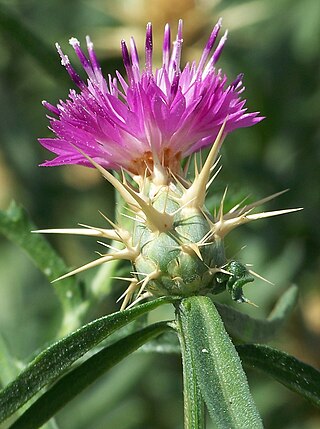
Centaurea calcitrapa is a species of flowering plant known by several common names, including red star-thistle and purple star thistle. It is native to Europe but is rarely found there, it is known across the globe as an introduced species and often a noxious weed. The species name calcitrapa comes from the word caltrop, a type of weapon covered in sharp spikes.

Centaurea solstitialis, the yellow star-thistle, is a species of thorny plant in the genus Centaurea, which is part of the family Asteraceae. A winter annual, it is native to the Mediterranean Basin region and invasive in many other places. It is also known as golden starthistle, yellow cockspur and St. Barnaby's thistle.

Centaurea montana, the perennial cornflower, mountain cornflower, bachelor's button, montane knapweed or mountain bluet, is a species of flowering plant in the family Asteraceae, endemic to Europe. It is widespread and common in the more southerly mountain ranges of Europe, but is rarer in the north. It escapes from gardens readily, and has thereby become established in the British Isles, Scandinavia and North America. This plant has become an invasive species in British Columbia, Canada. Centaurea montana grows in meadows and open woodland in the upper montane and sub-alpine zones, in basic areas. It grows to 30–70 centimetres (12–28 in) tall, and flowers mainly from May to August.

Centaurea melitensis is an annual plant in the family Asteraceae, 1 to 11 decimetres high, with resin-dotted leaves and spine-tipped phyllaries. This plant is native to the Mediterranean region of Europe and Africa. It was introduced to North America in the 18th century; the first documented occurrence in California is in the adobe of a building constructed in San Fernando in 1797. It is also naturalized on a number of Pacific islands.
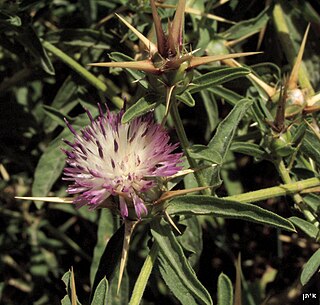
Centaurea iberica, the Iberian knapweed or Iberian star-thistle, is a species of Centaurea. It is native to southeastern Europe and southwestern Asia. It is known elsewhere as an introduced species and a noxious weed.

Centaurea jacea, brown knapweed or brownray knapweed, is a species of herbaceous perennial plants in the genus Centaurea native to dry meadows and open woodland throughout Europe. It grows to 10–80 centimetres (4–31 in) tall, and flowers mainly from June to September. It has simple leaves that are alternate in arrangement.
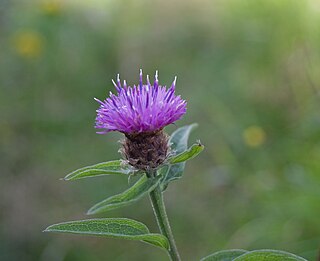
Centaurea nigra is a species of flowering plant in the family Asteraceae known by the common names lesser knapweed, common knapweed and black knapweed. A local vernacular name is hardheads.

Aethes smeathmanniana, or Smeathmann's aethes moth, is a moth of the family Tortricidae. It was described by Johan Christian Fabricius in 1781. It is found in most of Europe, Asia Minor and in North America, where it has been recorded from New Jersey and Newfoundland and Labrador.

Centaurea uniflora, the singleflower knapweed, is a perennial herbaceous plant belonging to the genus Centaurea of the family Asteraceae.

Centaurea macrocephala is a species of flowering plant in the family Asteraceae, and a member of the thistle tribe, Cardueae (Cynareae). It has many common names, including bighead knapweed, big yellow centaurea, lemon fluff, yellow bachelor's button, yellow hardhat, and Armenian basketflower.
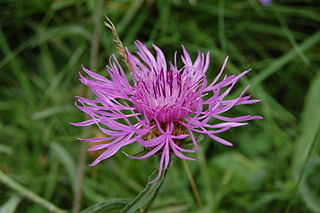
Centaurea aspera, the rough star-thistle, is a species of Centaurea found in Europe and in New York, United States.
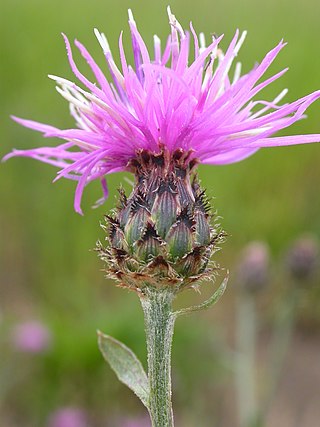
Centaurea stoebe, the spotted knapweed or panicled knapweed, is a species of Centaurea native to eastern Europe, although it has spread to North America, where it is considered an invasive species. It forms a tumbleweed, helping to increase the species' reach, and the seeds are also enabled by a feathery pappus.
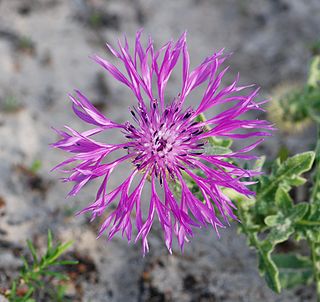
Centaurea sphaerocephala is a species of Centaurea found in the Iberian Peninsula.

Centaurea paniculata, the Jersey knapweed, is a species of Centaurea found in France and northern Italy.
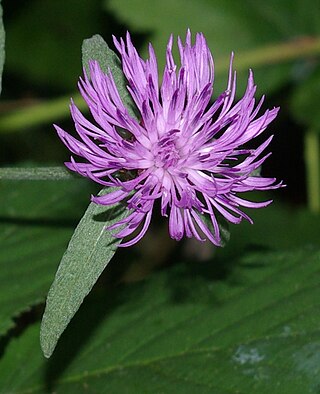
Meadow knapweed, also known as hybrid knapweed or protean knapweed, is a fertile hybrid between black knapweed and brown knapweed. The taxonomic status of the species is uncertain, and meadow knapweed has been variously described as different species.




















